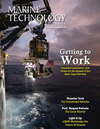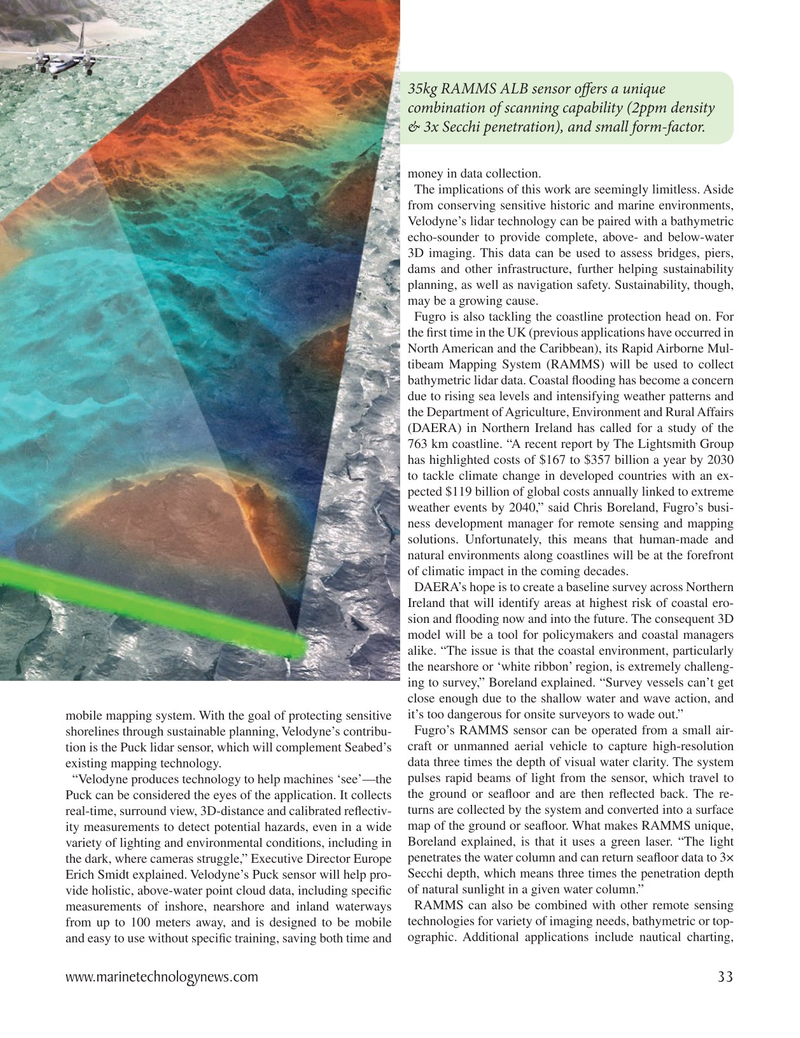
Page 33: of Marine Technology Magazine (July 2021)
Autonomous Vehicle Operations
Read this page in Pdf, Flash or Html5 edition of July 2021 Marine Technology Magazine
35kg RAMMS ALB sensor of ers a unique combination of scanning capability (2ppm density & 3x Secchi penetration), and small form-factor. money in data collection.
The implications of this work are seemingly limitless. Aside from conserving sensitive historic and marine environments,
Velodyne’s lidar technology can be paired with a bathymetric echo-sounder to provide complete, above- and below-water 3D imaging. This data can be used to assess bridges, piers, dams and other infrastructure, further helping sustainability planning, as well as navigation safety. Sustainability, though, may be a growing cause.
Fugro is also tackling the coastline protection head on. For the ? rst time in the UK (previous applications have occurred in
North American and the Caribbean), its Rapid Airborne Mul- tibeam Mapping System (RAMMS) will be used to collect bathymetric lidar data. Coastal ? ooding has become a concern due to rising sea levels and intensifying weather patterns and the Department of Agriculture, Environment and Rural Affairs (DAERA) in Northern Ireland has called for a study of the 763 km coastline. “A recent report by The Lightsmith Group has highlighted costs of $167 to $357 billion a year by 2030 to tackle climate change in developed countries with an ex- pected $119 billion of global costs annually linked to extreme weather events by 2040,” said Chris Boreland, Fugro’s busi- ness development manager for remote sensing and mapping solutions. Unfortunately, this means that human-made and natural environments along coastlines will be at the forefront of climatic impact in the coming decades.
DAERA’s hope is to create a baseline survey across Northern
Ireland that will identify areas at highest risk of coastal ero- sion and ? ooding now and into the future. The consequent 3D model will be a tool for policymakers and coastal managers alike. “The issue is that the coastal environment, particularly the nearshore or ‘white ribbon’ region, is extremely challeng- ing to survey,” Boreland explained. “Survey vessels can’t get close enough due to the shallow water and wave action, and mobile mapping system. With the goal of protecting sensitive it’s too dangerous for onsite surveyors to wade out.” shorelines through sustainable planning, Velodyne’s contribu- Fugro’s RAMMS sensor can be operated from a small air- tion is the Puck lidar sensor, which will complement Seabed’s craft or unmanned aerial vehicle to capture high-resolution existing mapping technology. data three times the depth of visual water clarity. The system “Velodyne produces technology to help machines ‘see’—the pulses rapid beams of light from the sensor, which travel to
Puck can be considered the eyes of the application. It collects the ground or sea? oor and are then re? ected back. The re- real-time, surround view, 3D-distance and calibrated re? ectiv- turns are collected by the system and converted into a surface ity measurements to detect potential hazards, even in a wide map of the ground or sea? oor. What makes RAMMS unique, variety of lighting and environmental conditions, including in Boreland explained, is that it uses a green laser. “The light the dark, where cameras struggle,” Executive Director Europe penetrates the water column and can return sea? oor data to 3×
Erich Smidt explained. Velodyne’s Puck sensor will help pro- Secchi depth, which means three times the penetration depth vide holistic, above-water point cloud data, including speci? c of natural sunlight in a given water column.” measurements of inshore, nearshore and inland waterways RAMMS can also be combined with other remote sensing from up to 100 meters away, and is designed to be mobile technologies for variety of imaging needs, bathymetric or top- and easy to use without speci? c training, saving both time and ographic. Additional applications include nautical charting, www.marinetechnologynews.com 33
MTR #5 (18-33).indd 33 7/30/2021 11:34:42 AM

 32
32

 34
34
